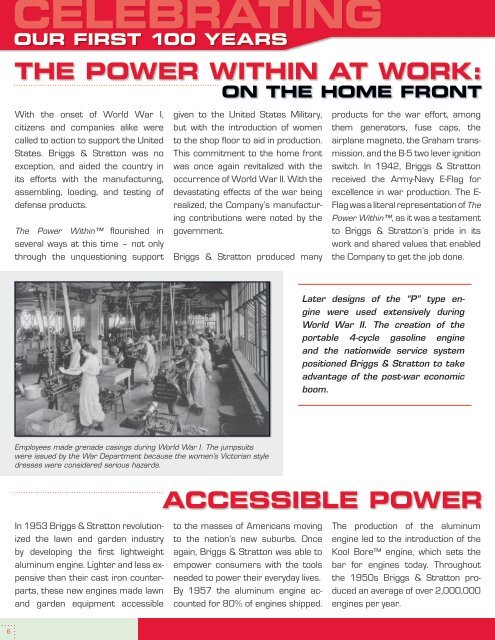The History of Briggs & Stratton - basco
The History of Briggs & Stratton - basco
The History of Briggs & Stratton - basco
You also want an ePaper? Increase the reach of your titles
YUMPU automatically turns print PDFs into web optimized ePapers that Google loves.
CELEBRATING<br />
OUR FIRST 100 YEARS<br />
THE POWER WITHIN AT WORK:<br />
ON THE HOME FRONT<br />
With the onset <strong>of</strong> World War I,<br />
citizens and companies alike were<br />
called to action to support the United<br />
States. <strong>Briggs</strong> & <strong>Stratton</strong> was no<br />
exception, and aided the country in<br />
its efforts with the manufacturing,<br />
assembling, loading, and testing <strong>of</strong><br />
defense products.<br />
<strong>The</strong> Power Within flourished in<br />
several ways at this time – not only<br />
through the unquestioning support<br />
In 1953 <strong>Briggs</strong> & <strong>Stratton</strong> revolutionized<br />
the lawn and garden industry<br />
by developing the first lightweight<br />
aluminum engine. Lighter and less expensive<br />
than their cast iron counterparts,<br />
these new engines made lawn<br />
and garden equipment accessible<br />
given to the United States Military,<br />
but with the introduction <strong>of</strong> women<br />
to the shop floor to aid in production.<br />
This commitment to the home front<br />
was once again revitalized with the<br />
occurrence <strong>of</strong> World War II. With the<br />
devastating effects <strong>of</strong> the war being<br />
realized, the Company’s manufacturing<br />
contributions were noted by the<br />
government.<br />
<strong>Briggs</strong> & <strong>Stratton</strong> produced many<br />
Employees made grenade casings during World War I. <strong>The</strong> jumpsuits<br />
were issued by the War Department because the women’s Victorian style<br />
dresses were considered serious hazards.<br />
ACCESSIBLE POWER<br />
to the masses <strong>of</strong> Americans moving<br />
to the nation’s new suburbs. Once<br />
again, <strong>Briggs</strong> & <strong>Stratton</strong> was able to<br />
empower consumers with the tools<br />
needed to power their everyday lives.<br />
By 1957 the aluminum engine accounted<br />
for 80% <strong>of</strong> engines shipped.<br />
Later designs <strong>of</strong> the “P” type en-<br />
gine were used extensively during<br />
World War II. <strong>The</strong> creation <strong>of</strong> the<br />
portable 4-cycle gasoline engine<br />
and the nationwide service system<br />
positioned <strong>Briggs</strong> & <strong>Stratton</strong> to take<br />
advantage <strong>of</strong> the post-war economic<br />
boom.<br />
products for the war effort, among<br />
them generators, fuse caps, the<br />
airplane magneto, the Graham transmission,<br />
and the B-5 two lever ignition<br />
switch. In 1942, <strong>Briggs</strong> & <strong>Stratton</strong><br />
received the Army-Navy E-Flag for<br />
excellence in war production. <strong>The</strong> E-<br />
Flag was a literal representation <strong>of</strong> <strong>The</strong><br />
Power Within, as it was a testament<br />
to <strong>Briggs</strong> & <strong>Stratton</strong>’s pride in its<br />
work and shared values that enabled<br />
the Company to get the job done.<br />
<strong>The</strong> production <strong>of</strong> the aluminum<br />
engine led to the introduction <strong>of</strong> the<br />
Kool Bore engine, which sets the<br />
bar for engines today. Throughout<br />
the 1950s <strong>Briggs</strong> & <strong>Stratton</strong> produced<br />
an average <strong>of</strong> over 2,000,000<br />
engines per year.


